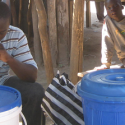Art in the lab: ‘Colourful’ bacteria in traditional Zambian products

Anneloes Groenenboom is a PhD student in the Laboratory of Genetics, Wageningen University and involved in the NWO Global Challenges Programme (GCP) project called “Zambian traditional fermented foods”. She has written this Story of change following the GCP training on November 1, 2017, facilitated by Perspectivity.
Art in the lab
Research with microbes usually does not result in the most beautiful pictures. During the yearly symposium of my graduate school a picture award was handed out. The theme of the competition was “How does your research show the beauty of our world?”. As my research is not visible to the naked eye, the beauty of it is difficult to show in a picture. I did not participate and no one was able to see my research.
Going to a contemporary art museum can change someone’s perspective of what beauty is. As a biologist I have to agree, beauty is in nature. Sometimes this beauty is cruel and difficult to understand. For millions of year human kind has tried to understand nature, using art, science or religion. We so far only understand parts of the nature around us, but we can fully appreciate its beauty. Contemporary arts rarely represent true nature. It is at most a personal interpretation of nature; the nature through the eyes of the artist.
But what if, instead of us making art that represents nature, nature makes the art?
My research project focuses on understanding microbial communities and evolution. This knowledge can help us to produce stable and safe fermented products. I study bacterial consortia of a traditional dairy product from Zambia. Some bacterial compositions are depicted here. Every colour represents a different bacterium. Every column represents another fermented product. This graphic representation holds valuable information on how bacterial compositions can be influenced by production method and evolution. But it sparked in me something completely different as well.
People crossing a street on a rainy day, children playing in a forest, a mountain landscape. With a bit of imagination a lot can be seen in this figure. My difficult job as a researcher is to find order in this supposedly random colour mess. I hope to be able to explain what we see. But before we get to that point we can embrace the nature as it is. Let’s be inspired its random and cruel beauty.
And what about you? I am curious to hear what you see in this graphic. Please share in the comments if and how you were sparked.
Do you want to know more about how the information depicted in the figure is used for our research? Visit the project page of Traditional Zambian Fermented Foods.
_ _ _
Written by Anneloes Groenenboom, PhD in the Laboratory of Genetics, Wageningen University.






